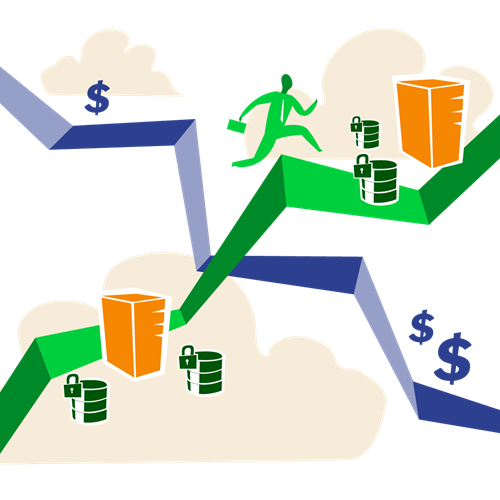ARTICLE 2 / 3
3 Factors to Consider When Developing a Hybrid Cloud Strategy
Phil Buckellew, president of the infrastructure modernization business unit at Rocket Software, on the unique value of cloud-based solutions and how to get the most out of your hybrid cloud strategy
By Neil Tardy
Developing a hybrid cloud strategy offers "the best of both worlds" to businesses that run IBM servers—i.e., the zSystems mainframe or Power Systems hardware—and are looking to modernize their operations.
This is the view of Phil Buckellew, president of the infrastructure modernization business unit for Rocket Software. "You get all of the capability, the security, the availability and the reliability that you've come to depend on from your traditional environments," he explains. "At the same time, you get the benefits that accrue from working with public clouds. You can scale up or scale down to zero—you have that elasticity—and you can implement changes very quickly."
The idea that the systems that have been running your business all along remain perfectly positioned to do their critical work in today's hybrid cloud-connected world is significant. While many successful modernization initiatives are underway, some have experienced setbacks. In the majority of those cases, Buckellew believes that clients equated modernizing with starting over completely.
“You don’t have to rip and replace. By embracing hybrid cloud, what you're actually doing is bringing everything together.”
— Phil Buckellew
"We typically see clients keeping their transaction processing in those traditional systems residing on their own premises," he says. "But some clients do try to move off the mainframe or their Power Systems servers only to realize that it doesn't make good business sense. That's because your existing systems are great at what they do. The scale-up transaction processing—that takes decades to perfect. You've got change control and other capabilities around the applications that run on those servers. And your systems continue to perform quite well—likely you sailed through the pandemic with your systems handling the spikes in utilization without any problems."
Likewise, cloud-based solutions provide their own unique value, starting with the specialized programming and development expertise available through contracting with modernization vendors or managed service providers (MSPs).
"You don't have to rip and replace," Buckellew adds. "By embracing hybrid cloud, what you're actually doing is bringing everything together."
Of course, modernization initiatives require time and ample corporate investment, but cloudifying traditional IT environments allows for the integration of new capabilities without disrupting your core operations. Buckellew's short-hand term for this process is hybrid modernization. He offers these recommendations for enterprises as they continue to expand their use of cloud-based tools and technologies.
Modernize your IBM Z with zPRO!
Velocity Software's goal with zPRO is to modernize the z/VM user interface and simplify user interactions with the platform.
The two required parts of modernization are the browser-based front end and having the APIs to manage the platform from off-platform functions.
Velocity Software has the only viable web server for z/VM. This provides flexibility and enables users to easily access the power of all of the native z/VM functions. Our APIs, based on our webserver for zPRO, provide a modern front end on the z/VM platform to both manage and simplify this great platform.
Focus on business objectives

In most cases, modernization is a long-term process consisting of a series of small but essential projects. You're not going to tackle everything in a week, or a quarter. The work involved in modernizing is ongoing. With this in mind, it's critical to identify specific business objectives.
"Sometimes organizations are told to go to cloud for no other reason than that's what their senior managers have been hearing about most recently," Buckellew says. "Obviously though, you have to start with the business objectives and the business outcomes. What are you trying to accomplish?"
One objective may be to simply leverage the value that your core systems provide. Of course, these systems house invaluable corporate data. But the data generated from these transactions, as well as other unstructured data, can also be used for analytics, workloads that are best suited for cloud-based environments.

"There's this mashup of things like IoT devices, company social media, or mobile phones used by your salespeople, and there's big upside in reusing this data," Buckellew says. For example, training models for fraud is something that many clients now do on the cloud. “This is the type of data that typically resides on cloud and benefits from the elasticity that cloud provides. So, it's really a matter of looking at your individual workloads and understanding where it makes sense to run them."
Seek cost efficiency

Often, the choice to move or host a workload on cloud can be a simple matter of economics. As noted, training models and other analytics workloads are particularly well-suited for the newer technology that predominates in cloud environments. In addition, enterprises that have long relied on tape storage are now finding an inexpensive option in public clouds. This extends to disaster recovery (DR), as the benefit of keeping a copy of critical business information offsite is readily apparent. As DR itself is in a rapidly evolving era, it's worth noting that many cloud providers now offer WORM storage, which has emerged as an effective combatant to ransomware.
"Storing a DR copy of your information in a public cloud can make a lot of sense," Buckellew says. "Cloud is also an option if you need particular DR capabilities that aren't in place on-premises."

Break down the silos
Modernization isn't simply a technological challenge. There's also the matter of your organizational structure. Particularly in the mainframe world, the concept of the silo is prevalent. Even within enterprises, there may be different groups—systems, storage, security—that have long been able to function autonomously. But in the age of cloud, these internal divisions are eroding.
"Many of our clients have deep silos across their teams, and what they're finding is when they start to break down those walls, they see benefits," says Buckellew.
In the cloud-enabled world, cross-functional teams that span both on-premises IT staff and personnel from cloud providers are collaborating. By capitalizing on the strengths of each environment, they're developing integrated solutions that allow for joint monitoring and management of on-premises and cloud-based workloads.


“Your mainframe and midrange systems may be older, but they’re still a critical part of the modern IT stack.”
— Phil Buckellew
You may not have all your technology under one roof, but everything you have and everything you need to do can fit under one virtual umbrella.
“Your mainframe and midrange systems may be older, but they're still a critical part of the modern IT stack," says Buckellew. "You just need the people in place to implement the tools that provide this integration.”
.png?v=03242023152510)